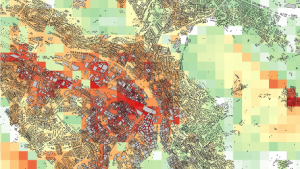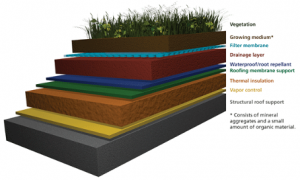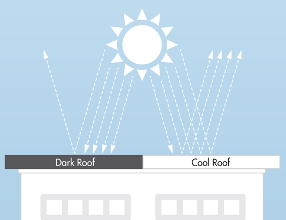Lorena Kuratle
There are two certainties, which are important for this text: First of all, climate change is happening and secondly cities are the future of living. These two facts also have a lot of interaction going on. With the increasing temperature in the future, the number of urban heat islands in cities will become bigger. How can we deal with this?

Figure 1: Heat islands in Zurich. (Empa / ETH Zürich / Gianluca Mussetti)
June 2017, 2018 or 2019, Zurich: It is hot, very hot. Sleepless nights, dizziness and breathing issues have been bothering me for a couple of days now. And I can suppose why: it’s the heat and the fact that it has been uncomfortably hot for days and nights.. I wish I could go to the countryside or swim in the Limmat or the lake all day, but I can’t, especially not at night. But maybe I could understand the mechanisms better and the possible measures to make it cooler again: Why is it hot anyway? What are efficient tools to adapt or mitigate this heat?
Urbanization and heat islands
The world is fully in the process of urbanization: The cities are continuously growing and becoming the place of everything: they are the hotspots of life, work, diseases and energy consumption. They are also the hotspot of heat in so called ‘urban heat islands’. Urban heat islands refer to the heating effect urban areas have. Cities are usually lacking soil moisture and vegetation and are consequently rather dry and dark-colored, (e.g. the pavement). The narrow surroundings in cities and the dark surface covers leads to a local heating of the air. This heated air mixes with the surrounding air and hence makes it warmer. Whereas in rural area during the night the surroundings and buildings can cool down again through the flux of cold air, in cities, through the channeling effect between the buildings and the huge amount of anthropogenic waste heat, such as heat from automobiles or air-conditioning, the warm or hot air stays within the city. Thus, the heat that is within an urban area, cannot not flow away, it stagnates and becomes an “heat island” (Hulley, 2012). Heat islands can be health-threatening, especially during a heat wave, such as the ones happened in the last couple of years, so it seems that something must be done to mitigate or even overcome them. In this short blog, I want to focus on roofs.

Figure 2: Layers in a green or living roof. (nps.gov)
Greening roofs
One possible mechanism to cool down buildings are green roofs, which structure is visible in Figure 2. Greening roofs can be implemented either intensively or extensively and have multiple benefits: living roofs help keeping the temperature in buildings low during a hot day, and warmer at night. This happens through transpiration or evaporative cooling (Hulley, 2012). The water in the plant, which has absorbed heat evaporates and ‘takes the heat away’. Thanks to this process, the energy consumption for heating and cooling can be reduced. Through this reduction of electricity consumption, the amount of waste heat is reduced and helps to a reduce the heat island effect. Not only do green roofs help cool down a building, they also help cleaning the air by filtering it. Another benefit of greening roofs is the retention of rainwater and therefore leads to an exoneration of the sewage system, but also to cleaner rainwater and a reduction of flood risks. Through the cleanse of rainwater, the water which flows into lakes and rivers is cleaner (Gago et al., 2013; Santamouris, 2014). Additionally, the green roofs help through biodiversity benefit, and pollination.
Cooling roofs

Figure 3: Cool roofs and dark roofs: reflection possibilities compared (gaf.com)
The other possible mechanism to cool down our urban roofs are the so-called ‘cool roofs’ as visible in figure 3. The function is simple: it works with the albedo effect. With brighter roofs the albedo-value can be increased, causing the roofs to reflect the light and heat back to the sky rather than to keep it stored, as it happens with dark roofs. As with green roofs, the overall energy demand decrease, because the energy required to cool the buildings can be reduced (Kolokotroni et al., 2013). The problem with this technique is that it always has to be adapted to the surrounding buildings. When not done properly there can be a reflection back to the intial roof, which would again lead to a heated area. (Bundesamt für Umwelt (BAFU), 2018). Additionally, cool roofs are not the only measure which can be taken to cool down a building, but actually it also helps to use natural materials, such as wood and to also insulate the buildings further, so that the energy transfer gets minimized, which is beyond the scope of this blog, but should certainly be looked further into.
Limitations and outlook
So, could we implement any of that in Zurich, to reduce the heat? To be honest, I don’t really know. The general rule is that, when there is a renovation or a construction, the roof shoud, if it’s economically and technically feasible, made green (Stadt Zürich, 2020). This rule however seems very vague, which is why the number of implemented green roofs is not really high. There is still a lot of potential and experts see the greening roof technique as the most successful method in cooling the city down, (Soukup & Häne, 2015). One very important benefit of the green roof is the low effort needed to maintain it. According to estimations there is about the area of the central park in New York City (!) in Zurich still available to be planted on roofs. (Arnet, 2018) So to summarize, it would be possible to make our roofs get even greener and thus our city cooler! There is little going on in Switzerland to increase the white roofs, so I suggest that further research is done.
Looking at the recommendations of the Federal Office of the Environment to tackle urban heat islands, it seems clear, that both greening and the whitening of roofs have great potential and should be further established (Bundesamt für Umwelt (Bafu), 2018).I, myself, will try to green my terrace further, so that I can create my own cool microclimate and if it gets too hot, I can still jump in the Limmat!
Literature
Arnet, H. (2018, August 8). Zürich muss kein Backofen sein. https://www.tagesanzeiger.ch/zuerich/stadt/ueber-der-stadt-muss-zuerich-gruener-werden/story/29923421
Bundesamt für Umwelt (Bafu). (2018). Hitze in Städten- Grundlage für eine klimaangepasste Siedlungsentwicklung.
Gago, E. J., Roldan, J., Pacheco-Torres, R., & Ordóñez, J. (2013). The city and urban heat islands: A review of strategies to mitigate adverse effects. Renewable and Sustainable Energy Reviews, 25, 749–758. https://doi.org/10.1016/j.rser.2013.05.057
Hulley, M. E. (2012). The urban heat island effect: Causes and potential solutions. In Metropolitan Sustainability (S. 79–98). Elsevier. https://doi.org/10.1533/9780857096463.1.79
Kolokotroni, M., Gowreesunker, B. L., & Giridharan, R. (2013). Cool roof technology in London: An experimental and modelling study. Energy and Buildings, 67, 658–667. https://doi.org/10.1016/j.enbuild.2011.07.011
Santamouris, M. (2014). Cooling the cities – A review of reflective and green roof mitigation technologies to fight heat island and improve comfort in urban environments. Solar Energy, 103, 682–703. https://doi.org/10.1016/j.solener.2012.07.003
Soukup, M., & Häne, S. (2015, Mai 7). Mit grünen Dächern gegen die Hitze. https://www.tagesanzeiger.ch/leben/gesellschaft/mit-gruenen-daechern-gegen-die-hitze/story/24108679
Stadt Zürich. (2020, Mai 5). Dachbegrünung. https://www.stadt-zuerich.ch/ted/de/index/gsz/beratung-und-wissen/wohn-und-arbeitsumfeld/dachbegruenungen.html#ziele_von_gruen_stadtzuerich
Media Attributions
- Figure 1: Empa / ETH Zürich / Gianluca Mussetti (https://www.empa.ch/web/s604/urban-heat-islands)
- Figure 2: nps.gov (https://www.nps.gov/tps/sustainability/new-technology/green-roofs/define.htm)
- Figure 3: gaf.com (https://www.gaf.com/en-us/for-professionals/resources/cool-roof-solutions)